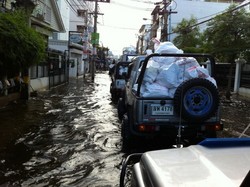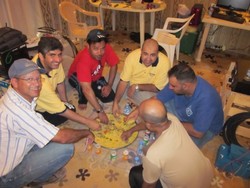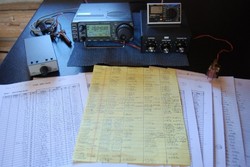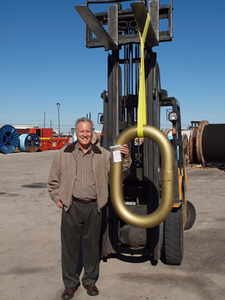 November 23, 2011 Editor: Ward Silver, NØAX | |||||||
IN THIS ISSUE
NEW HF OPERATORS - THINGS TO DO If you like CW and DX, shake off that trailing turkey torpor and join the throngs on ham radio's own "Black Friday" known as the CQ World Wide CW contest - a 48-hour cacophonous code carnival. The very next weekend brings an opportunity to whittle down your Top Band WAS list - the ARRL 160 Meter Contest. BULLETINS Get your logging software ready to go - update your program and supporting files now and not an hour before the contest starts! Jim AD1C reports that the Country (CTY) files were updated on 21 November 2011. Bob WA1Z has updated the Super Check Partial database files, as well. BUSTED QSOS Nothing horrendously inaccurate was reported to have leaked out in the last issue. CONTEST SUMMARY Complete information for all contests follows the Conversation section Nov 26-27
Dec 3-4
John K1AR reports that at least 7025 logs were received for the CQ WW SSB contest as the deadline passed - an increase of more than 1000 - nearly 15% - over the previous all-time total! The combination of new ham populations around the world, great high-band propagation, and the ease of submitting a Cabrillo-formatted log are resulting in big increases in scores and log submissions! As we approach the end of 2011, a look back at Contest Corral for the year finds 418 contests listed - not including contests that run more than once a month, such as the NS Sprints. Of the 418, there were 310 HF-only contests and 37 contests that only used the VHF+ bands. Most contests (72%) included CW - not bad for a mode now more than 170 years old! 47% featured phone operation and keeping with the trend of participation, 37% now have a digital component of the competition.
One of the additional digital contests is the new 10 Meter RTTY Contest sponsored by Ed WØYK and Don AA5AU. After taking a survey of RTTY contesters, it was decided to create a new low-power 10 meter contest - just in time for the great conditions of late. "By having this new contest occur the weekend before the ARRL 10-Meter Contest, it should give those who plan to operate the ARRL contest a chance to shake their stations down on 10 meters in a real contest beforehand and give die-hard RTTY contesters their own 10 meter contest. As an added incentive, Ed (owner of Muns Vineyard) is awarding a bottle of his excellent wine to the top ten single operators." Plaque sponsorships are also available for this brand-new contest as described on the website. With solar flux in abundance, Dan W7WA decided to find out what the all-time record is. "I recall from W3ASK's propagation column in CQ magazine it was sometime during cycle 19 and over 300. I did some Google searching and found some charts. Apparently the historical record for 10.7 cm solar flux measurements extends only back to 1947 (source: Wikipedia). Besides solar flux noteworthy for 1957 was that at times the planetary A index went up over 160. There were extended periods of elevated planetary A index lasting up to a week. So with 6 meter F2 openings there were probably extended periods of HF blackout/disturbed conditions. September 1957 looks to have been especially fraught with HF blackouts. During 1957 the solar flux ranged from 170 on May 18 to nearly 380 on December 23rd. Between December 12 and 23rd the flux jumped from 210 to nearly 380." We've got a ways to go to top that! Stew Perry plaque manager, Lew W7EW, writes that, "The plaque program for The Stew Perry TopBand Extravaganza is unique in that The Boring Amateur Radio Club does not decide what performances should be rewarded with wood. The radio combatants do that by sponsoring categories that they individually feel are important. These stalwarts choose the accomplishment that they want rewarded...and then the fight is on for that category." So far, the following plaques are sponsored: Sponsor - Category The winner of that last plaque gets an official Flying Doctors of VK Baseball hat instead of a plaque. If your Stew is in need of a warmup, try the QRP ARCI's Top Band Sprint the evening of 1 December before the ARRL 160 Meter Contest. How good are conditions? Here's a list that will give you an idea - the first six positions of the SSB Sweepstakes Single-Op, High Power top ten (N9RV, VY2ZM, KH7X, W7WA, KL7RA, and K7RL - as of Nov 22nd) include five stations located north of latitude 45N and a sixth that is nearly 2400 miles from the US West Coast! Amazing to see stations previously hobbled by propagation surging to the fore. Amateur Radio assistance is requested for the Plasma Thrust Shadow Experiment to be conducted on the International Space Station. The Central Research Institute of Machine Building (TSNIIMASH) in Russia is conducting a series of space plasma experiments in order to evaluate the shape of previously observed "dead" zones, or shadow-ing due to the firing of an onboard arcjet plasma source. Integration of electric thrust (ET) onboard a spacecraft poses a certain set of problems including electromagnetic compatibility. One matter of interest is that highly ionized exhaust plumes of ET may scatter RF signals producing a large "dead" zone for communications. See this ARRL Web story for complete details. Membership awards are often awarded towards the end of the year, such as Sigurd KJ1K who recently received the Packrats Rover Recognition Award. Sigurd operates a rover equipped from 50 MHz through 5 GHz, generating a lot of points in VHF+ contests for club members. Doesn't your club have deserving individuals who would appreciate recognition for their efforts?
Doug KR2Q posts some information to help explain the CQ WW log format extension of XQSO: at the beginning of each logged contact instead of the usual QSO: It indicates a QSO that you made but do not wish to be included as a claimed QSO. First, he notes that the correct way to find out the answer to a question about CQWW is to send an email to questions@cqww.com and not post it in a public forum. XQSO can be used to designate QSOs that don't comply with the restrictions of your category - for example, a contact made with high power although your log is submitted in a low power category, contacts made (accidentally, of course) outside your authorized frequency limits, or contacts of which you are unsure. By using XQSO and leaving the QSO in the log, you don't have to worry about creating penalties "on the other end." XQSO should appear very, very rarely - it is for accidents, not post-contest manipulation of the log. (See the Conversation section of this newsletter for more on that subject.) Contact the CQ WW committee for specific and official responses to questions. Ham radio made a great impression during the recent severe storms in Alaska as reported in this Alaska Dispatch article. (Thanks, William W3QX) While there is no contest activity on 60 meters, you can read this ARRL Web story about the FCC's recent update of the rules for operating on that band. Once again, CW is allowed on all amateur allocations! Web Site of the Week - Fans of the Northern California Contest Club newsletter, "The JUG" will be pleased to know that the new editors, Ian W6TCP and Stu K6TU are building on the work of former editor, Rob K6RB. They are busily turning the newsletter into a resource for contesters everywhere, not just in the NCCC region. You can see all the editions online! WORD TO THE WISE Assuming - don't do it! Even though your logging program thinks it knows an exchange, don't just blindly accept that data. Many stations may have a new QTH or the program could be wrong in guessing where the station is located. In CQ WW, that can cost you QSO points at the least and a multiplier at worst. Listen to what the station sends and log it! Kirk K4RO found this nice video about building Beverage antenna transformers. I especially like the "mount on lid, not box" idea.
Members of the Radio Amateur Society of Thailand (RAST) have been throwing themselves into relief efforts in response to the heavy flooding in Bangkok and other areas of Thailand. You know Champ E21EIC/KY1A as a contester but as the photo elsewhere in this issue shows, he is busy helping out with disaster communications, too. He has posted more photos and information online. The ARRL Contest Branch has been busy as reported by its manager, Sean KX9X. "2010 10 Meter certificates went out the door Friday. 2011 RTTY Roundup plaques and certificates are being worked on as we speak. Look for those to go out by the first week in December. You can follow ARRL contest awards processing status online, too. 2011 August UHF expanded results should be online by Monday, November 28. In the meantime, 1353 logs were received for 2011 SS CW before the deadline and 973 logs have been received so far for last weekend's SS Phone. Over 600 logs were submitted by 8 AM EST Monday morning, further validating the idea that the contest ends when the last QSO is made. Submit your log when the contest is over! The ARRL remains committed to having initial Sweepstakes results out in 60 days. All paper logs received for Sweepstakes are once again being converted to Cabrillo by a small group of dedicated data entry volunteers. We are not responsible for errors in conversion due to illegible handwritten logs. Contest clubs are continually encouraged to help their club members submit their logs electronically. Don't forget that the second CW Rookie Roundup is December 18 from 1800-2400 UTC. Get your club active and open your shacks to the newly-licensed and help them work and enjoy CW!"
The results of the UBA CW Contest 2011 have been published - go to the HF "TOP BAR" and the Contest Results "LEFT BAR". All participants will receive their UBN file in the coming week. (Thanks, Marc ON7SS - OO9O) Results for the QRP ARCI's Fall QSO Party Results are now online. The full result view brings up a rather large spreadsheet of information. (Thanks, Jim K9JWV) Getscores developer Gerry W1VE "...now has a beta page up which displays all scores sent to the site. (Meaning no configuration to see any particular contest.) The Grid refreshes in place, so no need to refresh the page. The grid allows you to group by any column, as well as Filter by any column. Want to see CQ-WW-CW results for SOLP Europe? No problem. How about all scores from only your contest club? Simple. The Grid is drag and drop... and very configurable."(Thanks, Gerry W1VE) OPERATING TIP To avoid a big metabolic shutdown during the contest - eat lightly and often so your stomach doesn't commandeer all that blood oxygen, shutting down your contest computer (the brain). Sometimes finding the right person to answer questions at the local power company is more difficult than the 80th section near the end of Sweepstakes! In the meantime, complete documentation and all sorts of valuable guying information and soil information can be found at the AB Chance civil construction web pages. (Thanks, Tom N4NW) Bill KB8WUP provides some handy design data from the telecom/utility industry. A 10-foot clearance (minimum) over finished grade is required where vehicular traffic is not expected. Over roadways, a minimum 17-foot clearance applies. He reminds us that the clearance should be at the lowestpoint in the sag of the cable or wires, including a little extra height margin to deal with ice loading and the resulting additional sag.
How high off the ground does a feed point need to be to be considered elevated enough to use tuned radials on 160? Your editor suggests 1.1 Antler or 1.1 UPS trucks high - whichever is greater. I don't thinkanybody has to ask how I might have learned this. Here's a new way to enter QRP categories from Lynn N7CFO. Nuff said. Julius N2WN humorously suggests that the recent invention of metal structures nearly as light as air could result in 160 meter Yagis liftable by one or two people! What makes the most effect Beverage termination? According to Frank W3LPL, researchers found that that the most stable all weather Beverage termination (especially in very dry weather) is a ground mat. The least expensive ground mat is chicken wire installed at the end of the Beverage. The mats used by the researchers is about 6 feet wide and roughly ¼-wavelength long at the lowest frequency of interest. Technical Web Site of the Week - Proceedings from the 2011 Microwave Update are now available as a low-cost print-on-demand book from Lulu or as a CD-ROM with some extra material. There is lots of material of interest to the active contester, particularly those VHF+ specialists. Here are just a few of the articles:
Put Your Pencils Down When those words were heard at the conclusion of standardized testing during my primary school years, we knew to drop 'em and sit back - the proctors were already snatching test forms off the desk! When the test was over, it was OVER. Would that was just as true of ham radio contests! Yet, there remains considerable confusion out there in radiosport land about what should happen between the last QSO and the log submission deadline. That period was originally required in the days of paper logs to go through and clean up handwriting, remove duplicate contacts, and generally make the log checkable - no computer software was involved. In addition, mailing in the log from faraway places often took some time.
These days, it's uncommon to NOT use a computer to log your contacts and with the Internet nearly ubiquitous, the resulting computer file can be sent to the sponsors in seconds. So as in golf, turn in your score card before you even take your spikes off! No other sport permits the participants a "do over" by allowing them to rewrite history by changing the submitted record of the competition. What do the ARRL HF Operating Guidelines have to say about it? Paraphrasing some of the information there, any information in your log at the end of the contest is what should go to the contest sponsors. If your information is wrong, so be it - everyone makes mistakes. It's possible to "sanitize" a log after the contest, but the correct answer is that the contest is over at the time the rules say it's over. Examples of post-contest log manipulation include editing times, correcting band changes, checking calls against the Callbook, checking against packet spots, looking through logs from other contesters, confirming calls and exchanges with your buddies, reading DX and contesting reflectors for news about rare calls, and even posting questions like, "did anyone get QSL info for that VQØ?" If someone asks you to confirm a QSO or information in the exchange, you should politely decline. After the log submission deadline, you can discuss anything you want, of course. If you're not sure about that QSO with KX1ABC, the time to make sure is during the contest. There are wide ranging opinions about the acceptability of editing your log after the contest. Most contesters would agree that if you made a note during the contest about an error, it's OK to fix it afterwards. Furthermore, it is generally OK to make a quick pass through the log immediately after the contest looking for "obvious" typos such as entering CT as CTT or changing 'o' to '0' - in fact, most logging software does such a check before creating the final log file. Correcting syntax errors reported by a log acceptance robot such as improper dates or multiplier abbreviations is also acceptable. Once you step over the line into making changes to what you think you "should" have logged, that's going too far. Reviewing your log is completely appropriate to help improve your operating accuracy and look for ways to improve strategy - in the NEXT contest. In fact, many top operators regularly review their logs and even record parts of contests in order to review and improve their operating practices. For example, when you get your log-checking report, you can go back to review busted calls and see what the other station really sent. This is an excellent way to discover where your weak spots are. A quick scan of last year's log will refresh your memory about when and where you worked those rare multipliers, too! It is encouraging to see so many logs submitted within minutes of the end of major contests, often a significant fraction of the final tally. That means contesters are "getting it" -we compete during the contest period and not afterwards. It is becoming a matter of pride that your log is turned in right away just as it is to compete ethically and by the rules. There is more work to be done - urge your peers to follow suit and join the clatter of pencils falling onto tabletops as the clock ticks over to 0000 Z. 23 November through 6 December An expanded, downloadable version of QST's Contest Corral in PDF format is available. Check the sponsor's Web site for information on operating time restrictions and other instructions. HF CONTESTS ARRL 160 Meter Contest--CW, from Dec 2, 2200Z to Dec 4, 1600Z. Bands (MHz): 1.8. Exchange: RST and ARRL/RAC section if US/VE. Logs due: Jan 3. Rules SKCC Straight Key Sprint--CW, from Nov 23, 0000Z to Nov 23, 0200Z. Bands (MHz): 1.8-28, 50. Monthly on the fourth Wednesday UTC. Exchange: RST, S/P/C, name, SKCC nr or power. Logs due: 5 days. Rules CQ World Wide CW Contest--CW, from Nov 26, 0000Z to Nov 27, 2400Z. Bands (MHz): 1.8-28. Exchange: RST and CQ zone. Logs due: Dec 21. Rules SARL Digital Contest--Digital, from Nov 27, 1300Z to Nov 27, 1600Z. Bands (MHz): 3.5-14. Exchange: RST and serial. Logs due: 7 days. Rules Top Band Sprint--Phone, CW, from Dec 2, 0000Z to Dec 2, 0600Z. Bands (MHz): 1.8. Exchange: RST, S/P/C, ARCI number or Power. Logs due: Dec 17. Rules SNS and NS Weekly Sprints--CW, from Dec 2, 0200Z to Dec 2, 0300Z. Bands (MHz): 1.8-14. Weekly on Thursday evenings local time. Exchange: Serial, name, and S/P/C. Logs due: 2 days. Rules TARA RTTY Mêlée--Digital, from Dec 3, 0000Z to Dec 3, 2400Z. Bands (MHz): 1.8-28. Exchange: RST and State/Province or serial. Logs due: Jan 1. Rules Top Operators Activity Contest--CW, from Dec 3, 1600Z to Dec 4, 1559Z. Bands (MHz): 3.5-28. Exchange: RST, serial, and TOPS/PRO number. Logs due: Dec 31. Rules AWA Bruce Kelly QSO Party--CW, from Dec 3, 2300Z to Dec 4, 2300Z. Multiple operating periods, see website. Bands (MHz): 3.5,7. Exchange: RST, Xmtr type, power, name. Logs due: 30 days. Rules 10 Meter RTTY Contest--Digital, from Dec 4, 0000Z to Dec 4, 2359Z. Bands (MHz): 28. Exchange: RST and state or province or serial. Logs due: Dec 15. Rules ARS Spartan Sprint--CW, from Dec 6, 0200Z to Dec 6, 0400Z. Monthly on the first Monday evening local time. Bands (MHz): 3.5-28. Exchange: RST, S/P/C, and power. Logs due: 2 days. Rules VHF+ CONTESTS SKCC Straight Key Sprint--CW, from Nov 23, 0000Z to Nov 23, 0200Z. Bands (MHz): 1.8-28, 50, Frequencies: Monthly on the fourth Wednesday UTC. Exchange: RST, S/P/C, name, SKCC nr or power. Logs due: 5 days. Rules http://www.skccgroup.com LOG DUE DATES 23 November through 6 December
ARRL Information Click here to advertise in this newsletter. Your One-Stop Resource for Amateur Radio News and Information ARRL membership includes QST, Amateur Radio's most popular and informative journal, delivered to your mailbox each month. Subscribe to NCJ - the National Contest Journal. Published bimonthly, features articles by top contesters, letters, hints, statistics, scores, NA Sprint and QSO Parties. Subscribe to QEX - A Forum for Communications Experimenters. Published bimonthly, features technical articles, construction projects, columns and other items of interest to radio amateurs and communications professionals. Free of charge to ARRL members: Subscribe to The ARRL Letter (weekly digest of news and information), the ARES E-Letter (monthly public service and emergency communications news), Division and Section news -- and much more! ARRL offers a wide array of products to enhance your enjoyment of Amateur Radio. Visit the site often for new publications, specials and sales. Donate to the fund of your choice -- support programs not funded by member dues! ACKNOWLEDGEMENTS ARRL Contest Update wishes to acknowledge information from WA7BNM's Contest Calendar and SM3CER's Contest Calendar. | |||||||












